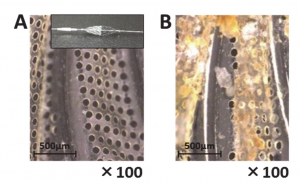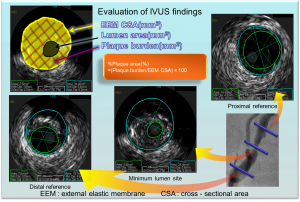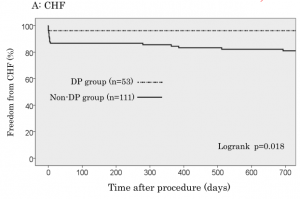当教室から最近発表された原著論文をご紹介します。
 寺本特任助教は関連病院勤務時代にまとめた急性心筋梗塞に対する末梢保護デバイスのデータから、本邦発のハイクオリティな末梢保護デバイスが急性期および慢性期の心不全発症を抑制し得ることを示しました。全症例でのIVUSデータの解析、心筋逸脱酵素値の詳細な検討により心筋内微小循環に関連した心不全発生機序への考察内容が評価され、本論文にはEditorialが付きました。
寺本特任助教は関連病院勤務時代にまとめた急性心筋梗塞に対する末梢保護デバイスのデータから、本邦発のハイクオリティな末梢保護デバイスが急性期および慢性期の心不全発症を抑制し得ることを示しました。全症例でのIVUSデータの解析、心筋逸脱酵素値の詳細な検討により心筋内微小循環に関連した心不全発生機序への考察内容が評価され、本論文にはEditorialが付きました。
Impact of Distal Protection with Filter-Type Device on Long-term Outcome after Percutaneous Coronary Intervention for Acute Myocardial Infarction: Clinical Results with Filtrap®
Teramoto R, Sakata K, Miwa K, Matsubara T, Yasuda T, Inoue M, Okada H, Kanaya H, Kawashiri MA, Yamagishi M, Hayashi K.
J Atheroscler Thromb. 2016; 23: 1313-1323. ![]()
Impact Factor 2.41 (2015)
AIM: Although distal embolization during percutaneous coronary  intervention (PCI) for acute myocardial infarction (AMI) deteriorates cardiac function, whether distal protection (DP) can improve prognosis is still controversial. We investigated whether a filter-type DP device, Filtrap®, could improve long-term outcomes after PCI for AMI.
intervention (PCI) for acute myocardial infarction (AMI) deteriorates cardiac function, whether distal protection (DP) can improve prognosis is still controversial. We investigated whether a filter-type DP device, Filtrap®, could improve long-term outcomes after PCI for AMI.
METHOD: We studied 164 patients (130 men, mean age: 65.7 years) who underwent PCI. Patients were divided into two groups based on the use of Filtrap®. The occurrence of congestive heart failure (CHF) and major adverse cardiac events (MACE) defined as cardiac death, recurrent AMI, and target vessel revascularization were compared.
RESULT: Between DP (n=53, 41 men, mean age: 65.5 years) and non-DP (n=111, 89 men, mean age: 65.8 years) groups, although there was significantly greater plaque area in the DP group than in the non-DP group, there were no significant differences in coronary reperfusion flow after PCI. Interestingly, patients with CHF in the non-DP group exhibited a higher CK level than those in the DP group. During a 2-year follow-up period, cumulative CHF was significantly lower in the DP group than in the non-DP group (log-rank p=0.018), and there was no significant difference in the MACE rate (log-rank p=0.238). The use of DP device could not predict MACE, but could predict CHF by multivariate analysis (odds ratio=0.099, 95% CI: 0.02-0.42, p=0.005).
CONCLUSION: These results demonstrate that favorable clinical outcomes could be achieved by the filter-type DP device in AMI, particularly in patients with CHF.
Editorial
Distal Protection During Primary Percutaneous Coronary Intervention for ST-elevation Myocardial Infarction. Ishihara M. J Atheroscler Thromb. 2016 Dec 1;23(12):1307-1308. ![]()
本研究の位置付け
急性心筋梗塞(AMI: acute myocardial infarction)の治 療はカテーテルインターベンション(PCI: percutaneous coronary intervention)の登場によって劇的な進化を遂げ、患者の予後は飛躍的に改善されました。しかし、約3割の症例でPCI中に生じる末梢塞栓などを原因としたSlow flow/No reflow現象(一旦改善した冠動脈血流が再び閉塞・亜閉塞状態に陥る現象)は心機能を著しく低下させ、予後不良因子と言われています。欧米で実施された末梢塞栓を防ぐためのデバイスの効果をみた臨床試験はいずれもnegativeな結果に終わり、現在ルーチンでの末梢保護デバイスの使用は推奨されていません。しかし、本邦のインターベンショニストの精緻な心カテ技術や日本製デバイスの品質と構造的特徴は末梢塞栓をより効率的に防ぎ、予後を改善させる可能性があります。そこで、我々はAMIの連続症例データを用いて、末梢保護デバイス使用群と非使用群に分け、死亡、心筋梗塞再発、心不全の発症などをアウトカムとして、これらを予測する因子を解析しました。
療はカテーテルインターベンション(PCI: percutaneous coronary intervention)の登場によって劇的な進化を遂げ、患者の予後は飛躍的に改善されました。しかし、約3割の症例でPCI中に生じる末梢塞栓などを原因としたSlow flow/No reflow現象(一旦改善した冠動脈血流が再び閉塞・亜閉塞状態に陥る現象)は心機能を著しく低下させ、予後不良因子と言われています。欧米で実施された末梢塞栓を防ぐためのデバイスの効果をみた臨床試験はいずれもnegativeな結果に終わり、現在ルーチンでの末梢保護デバイスの使用は推奨されていません。しかし、本邦のインターベンショニストの精緻な心カテ技術や日本製デバイスの品質と構造的特徴は末梢塞栓をより効率的に防ぎ、予後を改善させる可能性があります。そこで、我々はAMIの連続症例データを用いて、末梢保護デバイス使用群と非使用群に分け、死亡、心筋梗塞再発、心不全の発症などをアウトカムとして、これらを予測する因子を解析しました。
要旨
本研究では164例の急性心筋梗塞例のデータを解析し、 平均約2年のフォローアップ期間におけるイベント発生率を調査しました。また、全例で血管内超音波(IVUS: intra-vascular ultrasound)による冠動脈内プラーク量の測定を行い、臨床指標と併せてアウト
平均約2年のフォローアップ期間におけるイベント発生率を調査しました。また、全例で血管内超音波(IVUS: intra-vascular ultrasound)による冠動脈内プラーク量の測定を行い、臨床指標と併せてアウト カムを予測し得るかの解析を行いました。
カムを予測し得るかの解析を行いました。
その結果、末梢保護デバイスを使用した群では心不全の累積発症率が有意に低いことが判明し、更に末梢保護デバイスを使用せずにPCIを行うことは、その後の急性心不全や慢性期の心不全増悪による入院を予測する因子であることを明らかにしました(odds ratio=0.099, 95% CI: 0.02-0.42, p=0.005)。
今後の展望
PCIのみならず最適な薬物治療や心臓リハビリテーションの普及とともにAMI患者の予後はこの20年で大きく改善されました。しかし、本邦で一般的に行われている血栓吸引手技でさえエビデンスには乏しく、その治療戦略は1つ1つ検証していく必要があります。加えて冠動脈疾患治療デバイスの進歩は目覚ましく、技術革新が治療に反映されるエビデンスづくりを目指して、多施設での無作為化試験が望まれます。














